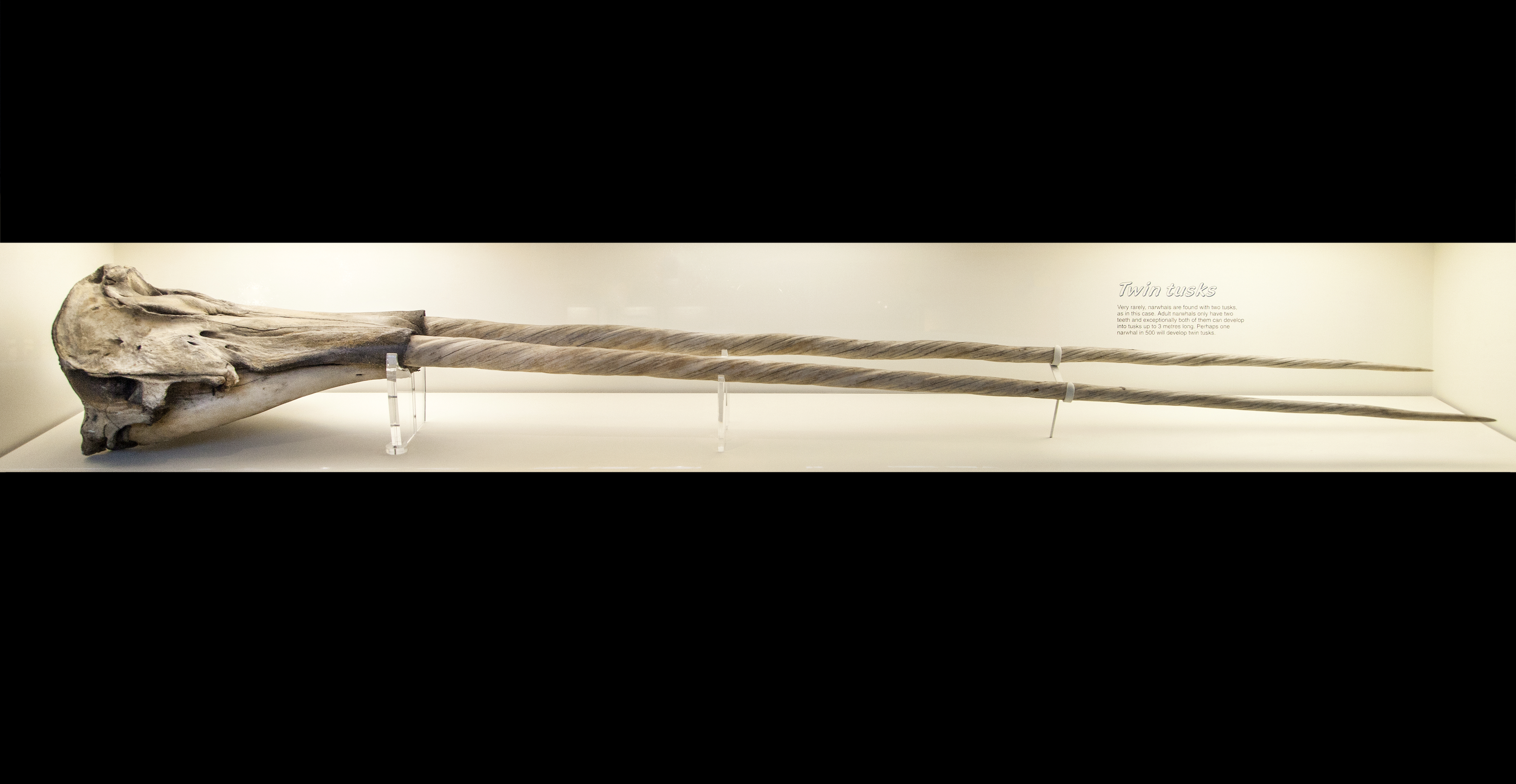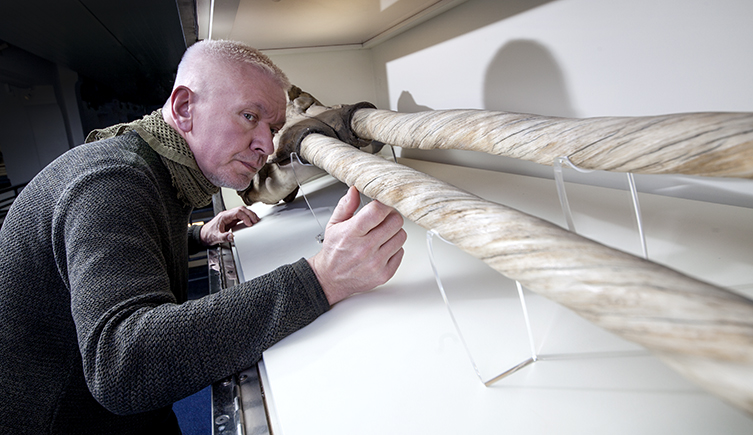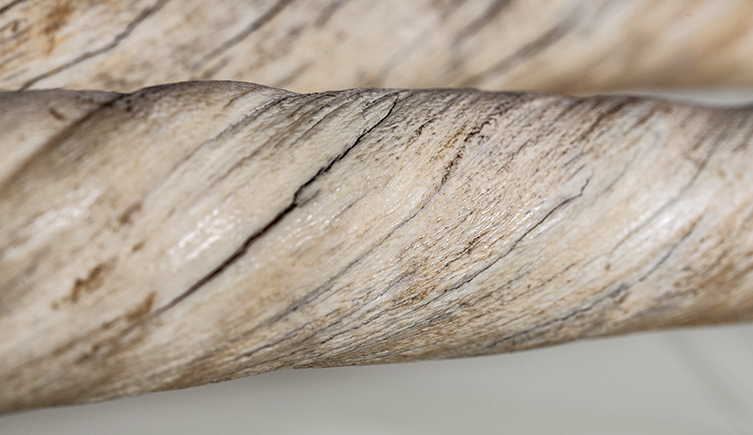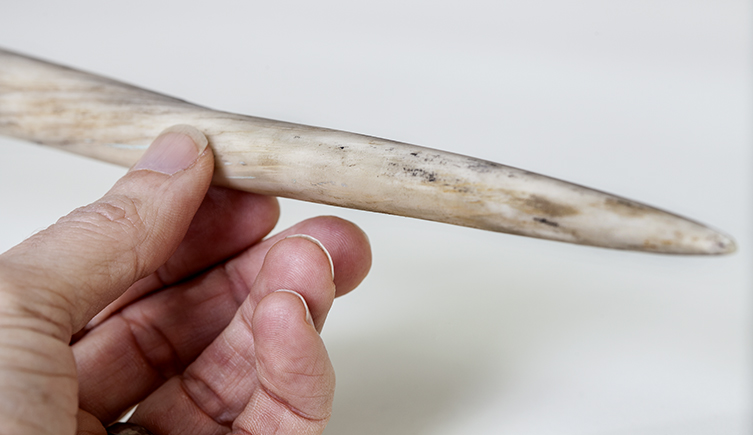Our marine mammal expert Richard Sabin takes us through what scientists know – and don’t know – about narwhals, also known as unicorns of the sea.
Ask a world-leading scientist a silly question, get a fascinating answer.

Two-tusked narwhal specimen on display on the mezzanine of the Mammals Gallery.
Our marine mammal expert Richard Sabin takes us through what scientists know – and don’t know – about narwhals, also known as unicorns of the sea.
Ask a world-leading scientist a silly question, get a fascinating answer.
Type of animal: mammal
Family: Monodontidae
Diet: carnivorous
Habitat: Arctic coastal waters and inlets
International Union for Conservation of Nature status: least concern
While Richard confirms there are no unicorns in the Natural History Museum, the collections we care for do include a solid representative sample of narwhals.
The collection includes a rare, two-tusked specimen and one of two animals that travelled all the way from the Arctic Circle to British waters in 1949.

Early illustration of two narwhals, or sea unicorns by E Cuvier. One has been depicted with two tusks.
Narwhals, Monodon monoceros, are toothed whales that live mostly in Arctic coastal waters and inlets. Male and female narwhals only have two teeth, which are both in the upper jaw.
The male’s iconic, spiralling tusk is in fact a canine tooth. It can grow up to three metres long.
Narwhal tusks were once a highly sought-after commodity. They were often collected by Inuit and traded to gullible Europeans as actual unicorn horn,
It’s possible that the spiral shape played a big part in informing the way unicorn horns have been depicted from medieval times to today.
“There is lots of evidence to suggest that the mythology which surrounds the unicorn could be based on the appearance of narwhal tusks that were traded down from the Arctic into Europe,” says Richard.

Marine mammal expert Richard Sabin examines the two-tusked Narwhal specimen on display in the Mammals Gallery.
“Seeing a tusk like that in isolation from anything else, you can imagine you’d be wondering what kind of beast it came from.”
Narwhals belong to a family called Monodontidae, which contains two species: the narwhal and the beluga, which is also known as the ‘white whale’.
Scientists are still on the fence about the evolutionary purpose of narwhal tusks. Butthere are a number of prevailing theories about their purpose.
“Although the tusks don’t appear externally in the female of the species, if you look inside the upper jaw and remove sections of bone as we have done with a few skulls in the collection, you can see two small, un-erupted tusks,” Richard says. “They might serve a purpose we’re not currently aware of, but they certainly have no external function.”
“In the majority of cases, erupted tusks appear only in males and the left-side tusk is the one that tends to emerge, growing with a left-handed spiral.”
“Very occasionally we see a rare case where the right tusk will also emerge and you’ll have quite a freakish-looking double-tusker, but it’s a very uncommon occurrence.”

Close up showing the leftward spiral of a narwhal tusk.
A study from 2014, showed that the surface of the tusk is actually covered in open pores leading to a central pulp core full of thousands of exposed nerve endings and blood vessels.
“In a human, that would not only be unpleasant but excruciatingly painful. With a narwhal, it appears that their tusk has some kind of large-scale sensory function,” Richard explains. “It could be that it allows them to detect changes in water temperature, salinity or water pressure. There’s a whole range of factors that we still need to quantify.”
Other theories are that male narwhals might use their tusks as a kind of pick to break through or break up channels in the ice, or that the size of the tusk is a visual indicator used by females for mate-selection.
According to Richard, a slanting wear pattern frequently found on the tips of tusks could offer an important clue to one of their uses.
“Some of the tusks in the collection show an oblique wear pattern, which could have been caused by a number of different behaviours, such as spearing their prey,” he says.

The tip of this narwhal tusk shows an oblique wear pattern.
There has also been a lot of discussion around the idea that male narwhals appear to use their long, lance-like tooth to intimidate each other, emerging side by side in the water and crossing tusks in a kind of combat.
Many adult males wear duelling scars from these encounters and some animals have been found with tusk tips lodged in their skull.
Recent drone footage has shed some light on the feeding practices of male narwhals. They were observed using their tusk to tap fish and stun them – similar to how killer whales corral fish and then stun them by slapping them with their tails.
“Like killer whales and most toothed cetaceans, narwhals are suction feeders, so you see them tapping the fish and sucking them in, swallowing them whole. It could be that this is one of the main functions of the tusk, or simply an opportunistic benefit the males have realised and incorporated into their feeding behaviour,” says Richard.
“Drone footage is enlightening because the drones are able to collect data in a way which is largely unobtrusive and they don't seem to affect the behaviour of the animals that are studied.”
Scientists have lots more to learn about narwhals, and drones could offer a great way to safely continue our observations. For now, we still don’t know what led to this unique, gender-specific use of the tusk.

The collections we care for include a rare double-tusked narwhal and a specimen that travelled all the way from the Arctic circle to Britain.
Among the narwhals in the collections we care for is an example found a long way from its Arctic home. In 1949, two narwhals – one male and one female – were recorded by the national cetacean strandings programme, originally set up by the Natural History Museum which has been monitoring British coastlines since 1913.
The female was found stranded in the River Medway in Kent, while the male made it all the way into the lower reaches of the Thames. The female was collected and incorporated into the research collection.
“Both strandings are what we call extra-liminal records as they were found way outside of the Arctic waters, where you would usually expect to find narwhals,” Richard explains.
“It could be that these two animals were suffering from disease or became disorientated, losing their way and growing weaker as they travelled further south. Perhaps they were pursued by killer whales at some point, we just don't know.”

Step 100 years into the future with Visions of Nature, our new mixed reality experience, to explore what could lie ahead for the planet.
Open until May 2026
£9.95

Find out more about why we need to protect oceans and read about the pioneering work of our marine scientists.

Just how weird can the natural world be?
Don't miss a thing
Receive email updates about our news, science, exhibitions, events, products, services and fundraising activities. We may occasionally include third-party content from our corporate partners and other museums. We will not share your personal details with these third parties. You must be over the age of 13. Privacy notice.
Follow us on social media